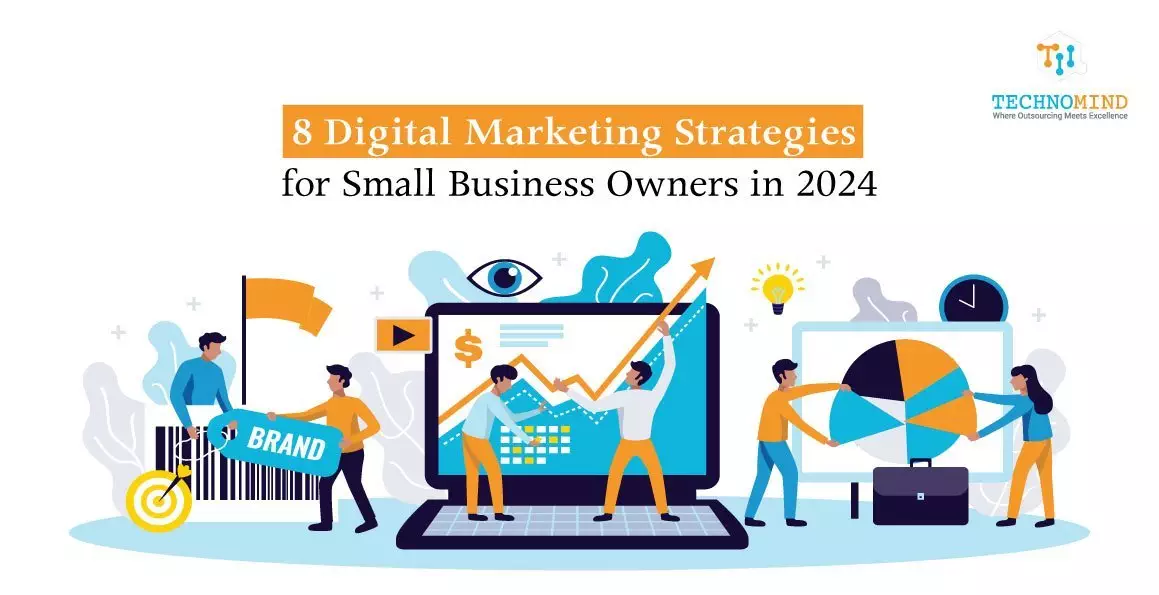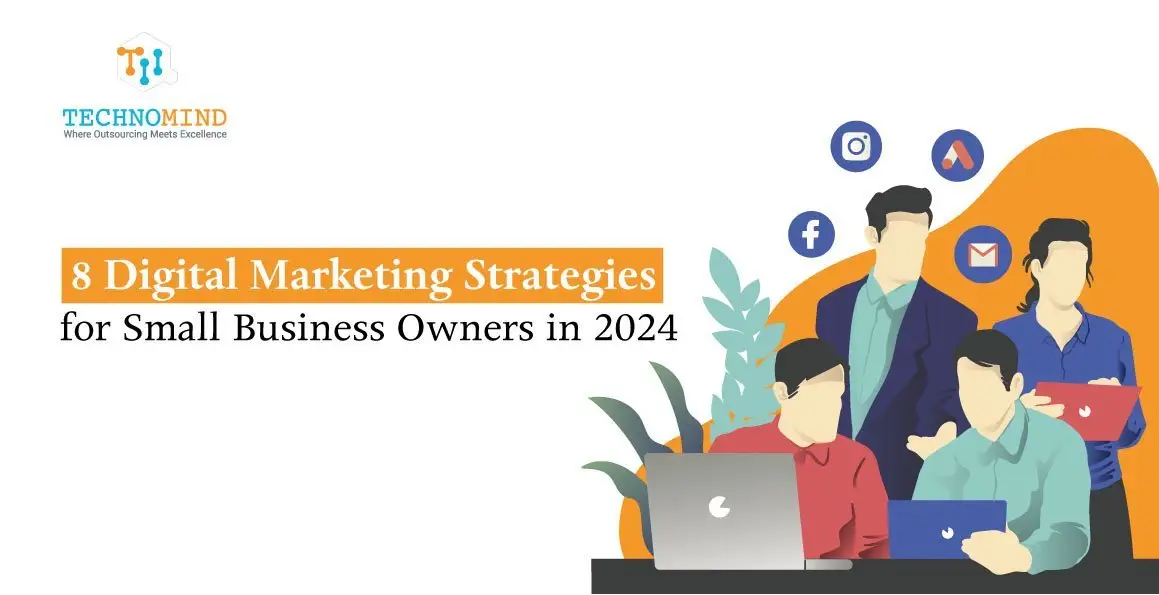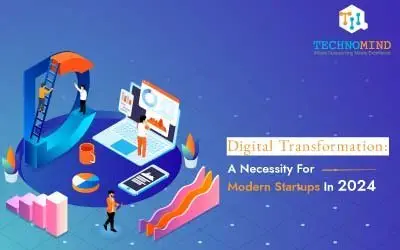Blog
8 Digital Marketing Strategies for Small Business Owners in 2024
The burning question for small business owners in 2024 is simple yet profound: How can you harness the power of digital marketing to propel your business forward? The more we more we reaches to the edges of 2024, the more important it is to get ready with the strategies so as for digital marketing too.
This article highlights the reasons why digital marketing is not only advantageous but also essential to the expansion and prosperity of small businesses.
What is Digital Marketing for Small Business Owners?
Digital marketing for small business owners involves utilizing online channels and tools to promote products or services. It goes beyond traditional advertising, embracing a range of strategies such as social media marketing, search engine optimization (SEO), email campaigns, and more.
In contrast to traditional approaches, digital marketing enables small firms to engage with their target audience in more economical way, increasing brand awareness and stimulating business expansion. It’s a dynamic strategy designed for the digital era that helps small businesses reach a wider audience and effectively compete in the modern workplace.
8 Benefits of Digital Marketing for Small Business
Cost-Effectiveness: Digital marketing often requires less financial investment than traditional marketing methods, making it an ideal choice for small businesses with limited budgets.
Global Reach: The internet breaks down geographical barriers, allowing small businesses to reach a global audience and compete on an international scale.
Targeted Advertising: Digital marketing enables businesses to precisely target their audience based on demographics, interests, and online behavior, ensuring that marketing efforts are focused on those most likely to convert.
Measurable Results: Analytics tools provide real-time data, allowing small businesses to track the performance of their marketing campaigns and make data-driven decisions for continuous improvement.
Brand Building: Digital marketing platforms offer opportunities for small businesses to build and strengthen their brand through engaging content, storytelling, and interactive experiences.
Customer Engagement: Social media and other digital channels facilitate direct communication with customers, fostering engagement and building lasting relationships.
Competitive Edge: An effective digital marketing strategy can help small businesses stand out in a crowded marketplace, gaining a competitive edge against larger competitors.
Adaptability: Digital marketing allows small businesses to adapt quickly to market trends and changes, ensuring they stay relevant and responsive to consumer needs.
8 Unavoidable Digital Marketing Strategies for Small Business in 2024
Search Engine Optimization (SEO):
Keyword Optimization:
- Comprehensive Research: Conduct thorough keyword research to identify relevant and high-impact keywords that align with your business and target audience.
- Strategic Placement: Integrate selected keywords naturally into your website’s meta titles, descriptions, headers, and content to enhance search engine visibility.
- Long-Tail Keywords: Incorporate long-tail keywords to capture specific search queries and attract a more targeted audience interested in niche topics.
Quality Content Creation:
- High-Quality Blog Posts: Create informative, valuable, and well-researched blog posts that address the needs and interests of your target audience.
- Evergreen Content: Develop evergreen content that remains relevant over time, attracting consistent organic traffic and establishing your website as a valuable resource.
- Multimedia Integration: Enhance content with multimedia elements, including images, videos, and infographics, to improve user experience and engagement.
Link Building:
- Internal Linking: Establish a network of internal links between relevant pages on your website to improve navigation, user experience, and distribute link equity.
- Quality Backlinks: Seek high-quality backlinks from reputable websites in your industry or niche to build authority and credibility with search engines.
- Guest Posting: Contribute guest posts to authoritative blogs in your industry, including relevant backlinks to your site, to increase visibility and attract organic traffic.
Mobile Optimization:
- Responsive Design: Ensure your website is responsive and offers a seamless experience across various devices, prioritizing mobile users.
- Mobile Page Speed: Optimize page speed for mobile devices to enhance user experience and meet the criteria set by search engines for mobile-friendliness.
- Mobile-First Indexing: Prioritize mobile versions of your content, as search engines increasingly use mobile-first indexing to rank and display search results.
Local SEO:
- Google My Business Optimization: Optimize your Google My Business profile with accurate business information, including name, address, phone number, and business hours.
- Local Citations: Establish consistent business information across online directories and platforms to enhance local search visibility and credibility.
- Customer Reviews: Encourage and manage customer reviews on platforms like Google and Yelp, as positive reviews contribute to local search ranking.
Technical SEO:
- XML Sitemap: Create and submit an XML sitemap to search engines to ensure efficient crawling and indexing of your website’s pages.
- Canonical Tags: Implement canonical tags to resolve duplicate content issues and signal the preferred version of a page to search engines.
- Schema Markup: Use schema markup to provide additional context to search engines, enhancing the display of rich snippets in search results.
Social Media Marketing:
Content Diversification:
- Visual Appeal: Create visually compelling content, including images and videos, to capture the attention of your audience in the fast-scrolling world of social media.
- Infographics: Share informative infographics that convey complex information in an easily digestible format, encouraging engagement and shares.
- Interactive Content: Incorporate polls, quizzes, and interactive posts to encourage participation, fostering a sense of community and increasing organic reach.
Audience Interaction:
- Timely Responses: Respond promptly to comments, messages, and mentions, showing your audience that their opinions and questions are valued.
- Live Sessions: Conduct live Q&A sessions, product demonstrations, or behind-the-scenes glimpses to connect with your audience in real-time.
- User-Generated Content Showcases: Share content created by your audience, showcasing their experiences with your products or services, and express appreciation.
Ad Campaigns:
- Targeted Advertising: Utilize the detailed targeting options provided by social media platforms to tailor your ads to specific demographics, interests, and behaviors.
- A/B Testing: Experiment with different ad creatives, copy, and audience segments through A/B testing to identify the most effective combinations.
- Retargeting Campaigns: Implement retargeting ads to re-engage users who have visited your website but did not complete a desired action, increasing conversion opportunities.
Strategic Hashtag Use:
- Branded Hashtags: Create and promote branded hashtags to encourage user-generated content and enhance brand visibility across social platforms.
- Trending Hashtags: Stay current with trending hashtags relevant to your industry or niche, joining conversations to expand your reach and visibility.
- Hashtag Campaigns: Develop and promote campaigns centered around specific hashtags, fostering a sense of community participation and engagement.
Content Marketing:
Strategic Blogging:
- Targeted Topics: Identify and address specific pain points, questions, or trends within your industry through targeted blog topics that resonate with your audience.
- Evergreen Content: Develop evergreen content that remains relevant over time, providing long-term value and attracting consistent organic traffic.
- Guest Blogging: Collaborate with industry influencers or experts for guest blog posts, expanding your reach and establishing authority.
Visual Content:
- Infographics and Data Visualizations: Communicate complex information or data in a visually appealing and easily digestible format through infographics and data visualizations.
- Video Content: Incorporate video content, such as tutorials, product demonstrations, or behind-the-scenes footage, to diversify your content and engage a broader audience.
- Custom Graphics: Design custom graphics and visuals that align with your brand identity, making your content more shareable and recognizable.
Storytelling:
- Brand Narrative: Develop a cohesive brand narrative that communicates your mission, values, and unique selling proposition to create a compelling story around your brand.
- Customer Success Stories: Share customer success stories and testimonials to humanize your brand, building trust and emotional connections with your audience.
- Sequential Storytelling: Craft content that unfolds sequentially, encouraging your audience to follow a narrative thread across multiple pieces of content, keeping them engaged.
Interactive Content:
- Quizzes and Polls: Create interactive quizzes and polls to encourage audience participation, providing a fun and engaging way to gather insights and feedback.
- Interactive Infographics: Develop infographics that allow users to interact with the content, providing a more immersive experience and increasing shareability.
- Webinars and Live Sessions: Host webinars or live sessions to facilitate real-time interaction, answering questions and addressing concerns while building a sense of community.
Content Distribution Strategy:
- Social Media Sharing: Develop a robust social media strategy to share and promote your content across various platforms, maximizing reach and engagement.
- Email Newsletters: Regularly distribute content through email newsletters, keeping your audience informed and engaged with your latest updates.
- Collaborations and Partnerships: Collaborate with influencers, other brands, or industry leaders to expand the distribution of your content and tap into new audiences.
Email Marketing:
- Segmentation: Divide your email list based on demographics, behaviors, or purchase history to send targeted and relevant content to different audience segments.
- Personalization: Tailor email content with personalized greetings, product recommendations, and exclusive offers to enhance engagement and conversion rates.
- Automation: Implement automated email campaigns for activities like onboarding, abandoned cart reminders, and follow-ups to streamline communication and nurture leads.
Voice Search Optimization:
- Conversational Keywords: Optimize content with natural, conversational language that mirrors how users speak when using voice-activated devices.
- FAQ Optimization: Anticipate and answer voice-search queries by incorporating frequently asked questions into your content.
- Mobile-Friendly Design: Ensure your website is mobile-friendly, as voice searches are often conducted through mobile devices.
User-Generated Content Campaigns:
- Contests and Challenges: Encourage users to create content through contests or challenges, fostering engagement and creativity.
- Customer Testimonials: Showcase positive customer experiences through user-generated testimonials and reviews.
- Hashtag Campaigns: Create branded hashtags to encourage users to share their experiences and content related to your brand on social media.
Chat Marketing with Messaging Apps:
- Instant Customer Support: Use messaging apps to provide real-time customer support, addressing queries and concerns promptly.
- Personalized Recommendations: Implement chatbots to deliver personalized product recommendations based on user preferences and behaviors.
- Order Tracking: Allow customers to track their orders and receive updates seamlessly through messaging apps for a frictionless experience.
AI-Driven Personalization:
- Behavioral Analysis: Use AI algorithms to analyze user behavior and tailor content recommendations based on individual preferences.
- Dynamic Website Content: Implement AI-driven personalization on your website to display dynamically generated content that adapts to each user’s interests.
- Predictive Analytics: Leverage AI for predictive analytics to anticipate customer needs, enabling proactive and personalized marketing strategies.
Conclusion:
In 2024, the digital landscape is a bustling marketplace where small businesses can thrive with the right strategies. Digital marketing is not merely a choice but a necessity for small business owners looking to compete, grow, and succeed in the modern business ecosystem. By embracing the power of digital marketing, small businesses can unlock a world of opportunities and establish a resilient presence in the digital frontier.
Digital Transformation: A Necessity for Modern Startups in 2024
As a matter of fact, in 2024, the business environment stands as witness to a fundamental reality: digital…
8 Best Digital Marketing Tacticts to Win Business in 2024
The definition of success in the marketing industry is constantly changing due to innovation and the ever-increasing demands of consumers…
How to Plan Digital Marketing for Tourism?
In an increasingly interconnected world where digital platforms have revolutionized the way we approach travel and exploration, the tourism…





0 Comments